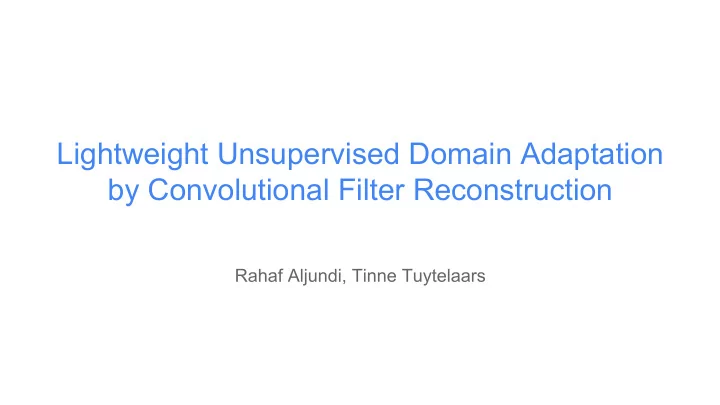

Lightweight Unsupervised Domain Adaptation by Convolutional Filter Reconstruction Rahaf Aljundi, Tinne Tuytelaars
Unsupervised Domain Adaptation When you expect the test data (Target) to be different from your training data (Source)
DA in the context of deep learning? - Fine-tuning needs labels also for Target. - Shallow DA methods don’t seem as powerful as before. - Deep DA methods tend to add extra layers and retrain the network.
Motivation: limitations of Deep DA methods - Source and Target data needs to be available at train time. - Training network takes a lot of resources and time. What if we want to adapt “on-the-fly” ? -> Light-weight DA - Use of-the-shelf pretrained network without retraining - Only limited amount of Source data needed
Motivation: early or late layers ? - A common practice is to freeze the first convolutional layers. - Is domain shift indeed something that happens only at later layers ? - Should we wait until the later layers to tackle domain shift ? What happens e.g. in case of a “simple” domain shift like color vs. grayscale ?
To examine this claim We visualize the output of each filter in each convolutional layer
To examine this claim We visualize the output of each filter in each convolutional layer The first layers are prone to domain shift The filters differ in their behavior
To examine this claim We compute the H-divergence of each filter in each convolutional layer
Convolutional Filter Reconstruction - Compute the divergence of the two datasets with respect to each filter as a measure for how “good” each filter is. - Use the “good” filters to reconstruct the output of the “bad” filters. - Exploit redundancy between filters.
Huh?
Huh?
Huh?
Convolutional Filter Reconstruction - LASSO feature selection for regression p p n B ∗ = argmin B { x ij β j ) 2 + λ X X X ( y i − β 0 − | β j |} i =1 j =1 j =1 - Bias towards selection of “good” filters p p n B ∗ = argmin B { x ij β j ) 2 + λ X X X | ∆ KL ( y i − β 0 − · β j |} j i =1 j =1 j =1
Experiments Applying Convolutional Filter Reconstruction to the first convolutional layer systematically improves the network performance by 2%-5%.
Experiments Table 1: Recognition accuracies on O ffi ce dataset Method Amazon → Webcam Amazon → DSLR Amazon → Amazon-Gray CNN(NA) 60.5 65.8 94.8 DDC[22] 61.8 64.4 - SVM-fc7(NA) 60.5 61.5 95.0 SA[3] 61.8 61.5 95.2 SA(First Convolutional) 61.5 65.8 95.1 Filter Reconstruction(Our) 62.0 67.2 97.0 Table 2: Recognition accuracies on variety of datasets Method Mnist → MnistM Syn → Dark Photo → Art CNN(NA) 54.6 75.0 85.2 Filter Reconstruction 56.7 80.0 86.7
Let’s look closer
Conclusion (part I) Light-weight method: - Takes only few mins. - Needs few unlabelled samples from the target set. - Limited amount of Source data needed. - And that’s only by changing the first layer.
Dynamic Filter Networks Bert De Brabandere, Xu Jia, Tinne Tuytelaars, Luc Van Gool
Video prediction - Consecutive video frames in, prediction of future frames out - No need for labeled data: self-supervised learning - Learn about transformations (filters)
Related work - Spatial transformer networks (Jaderberg et al. NIPS 2015, Patraucean et al. CoRR 16) - VQA dynamic parameters (Noh et al. CVPR16) - Dynamic convolution layer for weather prediction (Klein et al. CVPR15) - …
Dynamic Filter Networks General architecture
Dynamic Filter Networks In a traditional convolutional layer, the learned filters stay fixed after training. Model parameters : layer parameters that are initialized in advance and only updated during training Dynamically generated parameters : generated on-the-fly conditioned on the input
Dynamic Filter Networks Filter generation network Multilayer perceptron Convolutional neural network Any other differentiable architecture
Dynamic Filter Networks Dynamic filtering layer - Dynamic convolutional layer - Dynamic local filtering layer Filter-generating Filter-generating Input A Input A network network Input Input Input B Output Input B Output
Dynamic Filter Networks Dynamic local filtering layer filters conditioned on the input and also position transformation within the receptive field
Dynamic Filter Networks Dynamic local filtering layer filters conditioned on the input and also position transformation within the receptive field possiblity of adding dynamic bias
Dynamic Filter Networks Dynamic local filtering layer filters conditioned on the input and also position transformation within the receptive field possiblity of adding dyanmic bias possiblity of stacking several such modules (e.g. recurrent connection) need fewer model parameters than dynamic parameter layer and locally-connected layer
Dynamic Filter Networks Learning steerable filter Filter-generating θ = 45° network 0° 90° 139.2° 180° 242.9°
Dynamic Filter Networks Video prediction 0 0 0 0 0 0 0 0 0 1 0 0 0 0 0 t - 2 0 0 0 0 0 0 0 0 0 0 t - 1 SOFTMAX t t - 1 t t + 1
Dynamic Filter Networks MovingMNIST Input Sequence Ground Truth and Prediction
Dynamic Filter Networks MovingMNIST Model # Params Binary Cross Entropy FC-LSTM 142,667,776 341.2 Conv-LSTM 7,585,296 367.1 DFN (ours) 637,361 285.2
Dynamic Filter Networks MovingMNIST (Out-of-domain examples)
Dynamic Filter Networks Highway Input Sequence Ground Truth and Prediction
Dynamic Filter Networks Highway Input filters prediction Ground truth
Dynamic Filter Networks Highway
Dynamic Filter Networks Stereo prediction Input filters prediction Ground truth
Stereo prediction Left image Predicted disparity map Predicted right image Ground truth https://youtu.be/fAX8ji04xEU
Dynamic Filter Networks Classification
Questions !
Recommend
More recommend